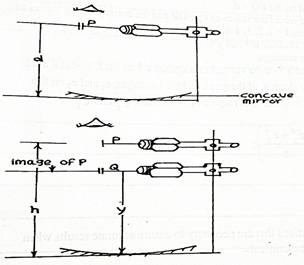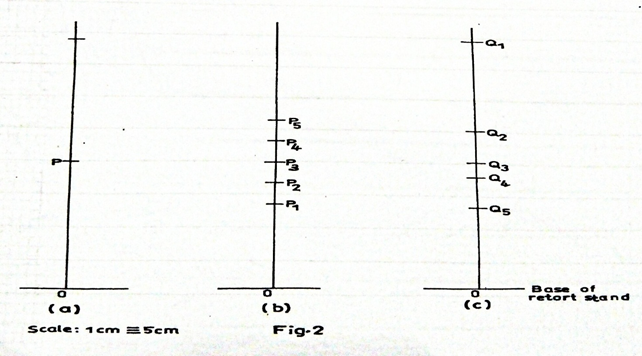Question 2A

A concave mirror is placed on the base of a retort stand and a pin, P, is held horizontally above the mirror as shown in the diagram above. The position of P is varied until its image in the mirror when viewed vertically downwards, coincides with it. The distance, d, between the image and the base of the retort stand is measured and recorded.
The position of P is adjusted so that it is at a height, h, (> 15 cm) from the base of the retort stand. A second pin, Q, is used to locate the position of the image of P, using the method of n parallax. The distance, y, between the position of Q and the base of the retort stand is measured and recorded.
This procedure is repeated for four other positions of P.
In figure 2(a), shows the position P when its image formed by the concave mirror coincides with it. represents the distance mi between P and the positions of the illuminated object Oi.
In figure 2(b), shows the position of P relative to the base of the retort stand, while figure 2(c) shows the corresponding position Q above the base of the retort stand.

- State two precautions that are necessary to ensure accurate results when performing this experiment.
(b) (i) Explain with the aid of a labelled diagram, how a concave mirror can be used to
produce an enlarged, upright image of an object.
(ii) A concave mirror of focal length 10 cm forms an image of an object placed 20 cm from its pole. Calculate the magnification produced.
Observation
Part (a) Performance was below average. Moss candidates evaluated h-1 and y-1 of the raw values instead of the converted values. Also, many candidates plotted the reciprocals of the raw values of h an y instead of converting them before finding the reciprocals.
Part (b) Candidates’ responded poorly in this part as many candidates could not differentiate a mirror from a lens and a convex mirror from a concave mirror.
The expected answers are that candidates should:
- correctly measure and record to at least 1 d.p and within tolerance of ± 0.1 cm
raw value of d
- correctly convert value of d
- correctly measure and record to at least 1 d.p and within tolerance of ± 0.1 cm
five values of hraw
- correctly convert five values of h
- correctly measure and record to at least 1 d.p and within tolerance of ± 0.1 cm
five values of yraw
- correctly convert five values of y
- correctly evaluate to at least 3 d.p five values of h-1
- correctly evaluate to at least 3 d.p five values of y-1
show composite table with h, y, h-1 and y-1
